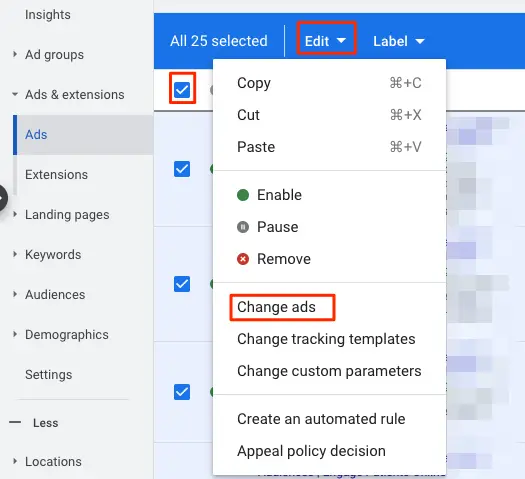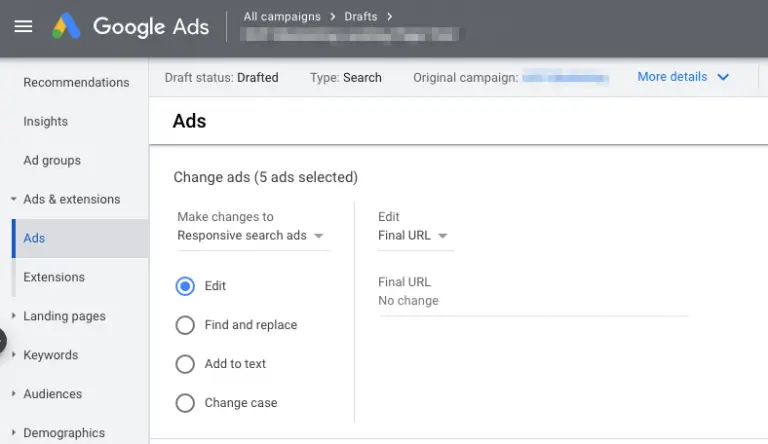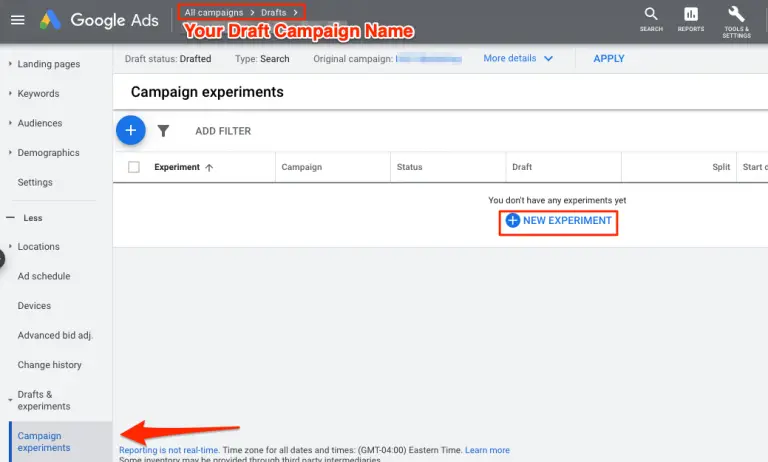Google Ads Experiment to A/B Test Campaigns and Landing Pages
What is an experiment in Google Ads?
An experiment in google ads is a form of A/B testing. You can test multiple variants like landing pages, bidding strategies, or an entire ad group. Google Ads experiments let you A/B test changes to search and display campaigns before implementing them.
We have to distinguish between drafts and experiments in Google Ads.
Google Ads Drafts let you prepare multiple changes before pushing them live.
Google Ads Experiments take the changes made in drafts into action and let you measure results to understand the impact. When an experiment or test was successful you can apply the changes to your campaign with a single click.
In this tutorial, I will walk you through every step on how to create drafts and experiments in Google Ads. We will use the example of A/B testing two different Landing Pages.
Creating a draft in Google Ads
Attention: before creating the draft, make sure everything is set up correctly like measuring conversions, budget, ad copy, etc. because if you want to make changes you will have to do them twice after the draft is created.
When you create a draft you mirror a current campaign with all its settings. You can then edit the draft as if you would normal campaigns while keeping the live campaign as is.
In Google Ads navigate to campaign drafts in the left panel. In the left navigation bar scroll to the bottom -> show More -> Drafts & Experiments -> Campaign Drafts or use the search function in the main navigation to locate campaign drafts:

In campaign drafts select the campaign you would like to modify, give the draft a name, type in a description, and hit save.
Automatically, you will be directed to the Ad Groups of the selected campaign to make the changes you’d like to test. Since we would like to change the landing page, we will have to go one level deeper into the ads.
Change the variable you’d like to test
In our case, we would like to change the ads so we navigate to the Ads section. We select all ads and edit them like in the following screenshots:


We select the variable we would like to edit. In our case “Final URL” and insert the new landing page.
Next, you head over Campaign experiments.
Creating an experiment in Google Ads
After you created a draft, made the changes to the campaign, ad group, or ads you need to create a new experiment:

Give your experiment a unique name, set the start date, potentially an end date, experiment split, and experiment split options. Let’s look at each of the options individually with some best practices:
Start date: Select a date when you would like to start your experiment. Consider some delays for required approvals when texting variants like ads or landing pages. This usually takes 24 hours. It’s best to schedule the experiment for 24 to 48 ahead of the present date. For easier analytics, select a specific date like the 1st or 15th of a month or a Monday.
End date: The end date is optional I suggest thinking about the data points before defining an end date. For example, if you test two landing pages to determine which converts better, you should collect a sufficient data size. Based on your current campaign performance you can calculate how long you should be testing before you can determine if one version performs better than the other. If you select no end date you can end the experiment manually at any time but don’t run into the risk that the experiment ends and you lose momentum in the test if you need to exceed the planned testing time period.
Experiment Split: Leave this at 50% to collect the most meaningful data. This is the fastest way to come to a conclusion.
(Advanced Option) Experiment Split Option:
- Search-based: The search-based split option splits the experiment based on your set split percentage for every search. This may defuse the results because the same user may get two different variants of the test.
- Cookie-based: The cookie-based split option displays the same variant for a returning user. This ensures the best experience for the user as well as the cleanest testing. It’s best practice to select cookie-based splitting for experiments in Google Ads.

After saving, your drafts and experiment are ready to run.
In the campaign overview, you will now see the experiment campaign among the existing campaigns. You will recognize the experiment symbol next to the campaign. Additionally, you will see that the campaign budget simulator is not available (greyed out) for the original and test campaign.

Review experiment performance
When you select the test campaign you will see a performance scorecard at the top of the dashboard that compares the performance of the experiment to the original campaign. Please note, it takes some time to display results. Google Ads needs to collect some data first. It’s common that this may take a few days into the test – even for large search advertising budgets.

Choose a winner and apply changes
If the experiment was successful and the draft campaign performed better and reached the pre-experiment determined winning criteria, you can apply the changes in two ways:
- Update the original campaign: The draft variables will be applied to the original campaign. In our case, the final URL will be swapped out with the original landing page. The new original campaign will keep running as usual with the winning landing page.
- Convert to a new campaign: The mirrored draft campaign with the tested variables will be converted into a new campaign while the original campaign will be automatically paused. The new campaign will run and show with your other campaigns as a regular active campaign.
A/B Testing and experiment table stakes
Number of variables
It’s crucial to only test one variant at a time when conducting experiments in Google Ads. If you were to test multiple variants at once, it will be impossible to identify the criteria that has performed better or worse than the original campaign.
Some great A/B tests that work well for Google Ads experiments:
- Testing final URLs (landing pages) as a whole
- Testing a small change to a landing page version like the CTA, shorter form, or website personalization
- Testing bid strategy from manual CPC to target CPA
- Testing bid strategy from maximizing clicks to conversion optimization
- Testing a new ad group all together
Making changes
Avoid making changes to the campaign while conducting the experiment. If you must make changes apply them to both the original and draft campaign to ensure that the experiment results are sufficient.
Winning criteria and experiment objective
The experiment objective and winning criteria should be determined before the experiment. Focus on a single metric you can measure in the time frame. It’s always recommended to write that down. For example, when testing two landing page variants, we want to analyze the conversion rate of the landing pages. If we also link to one version of the URLs through another campaign outside of the Google Ads experiment, it needs to be considered.
Write down the pre-experiment landing page conversion rate of the original variant and decide how much the variance needs to be to determine a winner.
Benchmark original conversion rate of the past 60 days: 2%
Winning criteria: the new landing page needs at least a 0.5%-point higher conversion rate over 60 days than the original version.
It’s also important to note when to stop the experiment. If one version is performing over 1%-point better/worse we will stop the experiment and declare the winner. Minimum time frame 30 days.
Enough time to run the experiment
It’s recommended to let tests run for a minimum of 4 to 6 weeks to let Google’s algorithm learn and optimize towards the objective and to collect enough data to make an informed decision.
Keep testing
After a successful experiment (a test is always successful if you come to a conclusion, regardless if the performance of the test was better or worse), design a new experiment to test further and optimize your campaigns. Remember to always test one variable at a time.

Sascha is a Lifecycle Marketing Consultant with over 8 years of digital marketing experiences in Silicon Valley, the UK, and Germany.
After leading the demand generation for a 100+ million company, he decided to venture out on himself. He’s now helping clients to attract and convert more leads and customers.
His main focus are SEO, paid media & marketing automation – all with the focus to tie marketing campaigns to revenue.
Sascha has been featured in industry publications.



